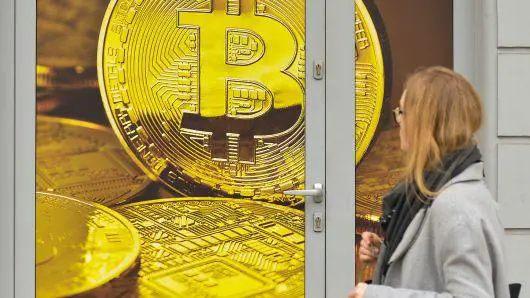The Federal Reserve on Wednesday raised the key lending rate for the first time this year to its highest level in a decade, citing a stronger outlook for US economic growth.
Newly installed Fed Chairman Jerome Powell presided over his first meeting, which raised the federal funds rate to 1.5-1.75 percent, a move that will affect all types of loans, from homes to cars to student debt.
In his first press conference as Fed chief, Powell pointed to the factors that have boosted the economic outlook in recent months, including "more stimulative" fiscal policy, in the wake of the massive tax cuts Congress passed in December.
In addition, he said "ongoing job gains are boosting incomes and confidence (and) foreign growth is on a firm trajectory."
That likely caused Fed officials to signal they expect a slightly more aggressive path for rate increases next year.
Federal Reserve Chairman Jerome Powell speaks at a news conference following the Federal Open Market Committee meetings in Washington, US, March 21, 2018.
Still, Powell told reporters that even with rising interest rates, the world's largest economy is "healthier than it has been since before the financial crisis. It's a healthier economy than it has been in 10 years."
However, he also acknowledged that central bankers now consider the prospects of a global trade war as a "more prominent risk" to the economic outlook.
President Donald Trump recently announced steep tariffs on aluminum and steel and is expected to take more tough action against Chinese goods this week, but Powell said officials did not specify whether rising trade frictions could impact growth or inflation.
In its quarterly forecasts, Fed officials project the benchmark interest rate will end this year at 2.1 percent, meaning two more hikes are likely, unchanged from the December forecast, but will rise to 2.9 percent at the close of 2019, implying three increases.
That would mean one more rate increase next year than previously expected, even though officials do not anticipate inflation to rise any faster. The Fed's preferred inflation measure is forecast barely move up to 2.0 percent in 2019.
In fact, Powell said, "there is no sense in the data that we are on the cusp of an acceleration of inflation."
While the Fed is "very alert" to any increases that could result from the very low unemployment rate, which normally would be expected to drive wage increases, "It's not something we observe at the present."
The Dow finished down 0.2 percent at 24,682.31 after rallying as high as 24,977.65 shortly after the Fed announcement.
Confidence in the economy
The rate hike was the latest step away from years of stimulating the world’s largest economy in the wake of the 2007-2009 financial crisis and recession. The Fed tightened policy three times last year.
The combination of 1.8 trillion US dollars in expected fiscal stimulus from the Trump administration and recent hints of price and wage pressures had prompted some Fed officials to speculate more Americans could be drawn into an already tight labor market.
Some even worried inflation could rise well above the Fed’s target if the economy got too hot.
Policymakers were largely split on Wednesday as to whether a total of three or four rate hikes would be needed this year. They predicted rates would rise three times next year and two times in 2020, a further indication of their view that the economy is on solid footing.
“The Fed seems to be gaining confidence,” said Brian Coulton, an economist at Fitch Rating in London.
Fed policymakers projected US economic growth of 2.7 percent in 2018, an increase from the 2.5-percent forecast in December, and also marked up growth for next year. The Fed’s preferred measure of inflation was expected to end 2018 at 1.9 percent, unchanged from the previous forecast, but it is seen rising a bit above the target next year.
The US unemployment rate by the end of 2018 is expected to edge down to 3.8 percent, indicating the Fed sees more room for the labor market to run. Fed officials predicted the longer-run rate would settle at 4.5 percent, slightly lower than the forecast from December.
Dollar falls
The dollar's trajectory was more decisive, falling after the Fed announcement and not moving significantly after that.
"While there were some aspects of today's announcement that were perhaps more hawkish than some expected, ultimately the currency market appeared to focus on the unchanged projection of a total of three rate hikes for 2018, which perhaps disappointed some who expected policymakers to signal a more aggressive near-term rate path," said Nick Bennenbroek, head of currency strategy at Wells Fargo Securities.
Earlier, European markets avoided major swings, with Frankfurt ending flat and London and Paris both down modestly.
Brent oil prices rose three percent to 69.47 US dollars per barrel after a US petroleum inventory report showed lower commercial inventories.
The data added to optimism about oil prices after a committee working for the Russia-OPEC group that has capped output on Tuesday said global supplies would balance with demand by the end of September, sooner than previous forecasts.
Petroleum-linked shares jumped, with Dow members Exxon Mobil and Chevron rising 1.4 percent and 2.2 percent respectively.
But packaged food companies stumbled after General Mills warned that steepening commodity costs would dent profits. General Mills tumbled 8.9 percent while Kellogg dropped 4.0 percent, Campbell Soup 2.2 percent and Mondelez International 0.8 percent.
Tesla Motors gained 1.9 percent after shareholders approved a pay package worth potentially billions of dollars for chief executive Elon Musk if the company meets its targets for operations and market capitalization.
(AFP&REUTERS)
 简体中文
简体中文

